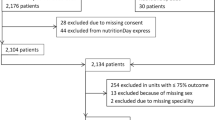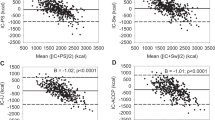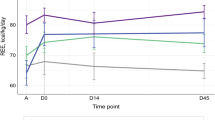Abstract
BACKGROUND:
Many methods are available to determine energy requirements, however, all have limitations, particularly when used for the obese.
OBJECTIVES:
The aim of this survey was to investigate current practice in the estimation of energy requirements in an underweight and obese hospitalised patient in a large cohort of UK dietitians.
SUBJECT/METHODS:
A cross-sectional anonymous online survey of UK registered dietitians was performed.
RESULTS:
A total of 672 responses were received. Underweight patient: prediction equations with adjustment for metabolic stress and physical activity were most commonly used (90%). The median estimated energy requirement was 2079 kcals/day. The estimated energy requirement using calorie per kilogram method was significantly lower compared with equations (P<0.001). The median target volume of feed prescribed was 2000 mls/day. A significant reduction in feed prescribed compared with estimated energy requirements was found (P<0.001). Obese patient: prediction equations to estimate the basal metabolic rate alone were most commonly used (51%). Nutrition support dietitians used a lower stress factor compared with non-nutrition support dietitians (P=0.016). Method used to estimate the energy requirements was associated with years in clinical practice and place of work (P<0.001, 0.001). Calorie per kilogram used in the obese case study (median: 25 kcal/kg) was significantly lower than calorie per kilogram used in the underweight case study (median: 30 kcal/kg; P=0.014).
CONCLUSIONS:
A significant variation in the methods used by dietitians to estimate the energy requirements was found, particularly in the obese patient group. In an age of rapidly increasing rates of obesity a professional consensus of treatment of this patient group is needed.
This is a preview of subscription content, access via your institution
Access options
Subscribe to this journal
Receive 12 print issues and online access
$259.00 per year
only $21.58 per issue
Buy this article
- Purchase on Springer Link
- Instant access to full article PDF
Prices may be subject to local taxes which are calculated during checkout


Similar content being viewed by others
References
McWhirter J, Pennington C . Incidence and recognition of malnutrition in hospital. BMJ 1994; 308, 945.
Breen H, Ireton-Jones C . Predicting energy needs in obese patients. Nutr Clin Pract 2004; 19, 284–289.
Savard J, Faisy C, Lerolle N, Guerot E, Diehl J, Fagon J . Validation of a predictive method for an accurate assessment of resting energy expenditure in medical mechanically ventilated patients. Criti Care Med 2008; 36, 1175–1183.
Roza A, Shizgal H . The Harris-Benedict equation reevaluated - resting energy requirements and the body cell mass. Am J Clin Nutr 1984; 40, 168–182.
Frankenfield D, Roth-Yousey L, Compher C . Comparison of predictive equations for resting metabolic rate in healthy non-obese and obese adults: a systematic review. J Am Diet Assoc 2005; 105, 775–789.
Boullata J, Williams J, Cottrell F, Hudson L, Compher C . Accurate determination of energy needs in hospitalized patients. J Am Diet Assoc 2007; 107, 393–401.
Reeves MCS . Variation in the application of methods used for predicting energy requirements in acutely ill adult patients: a survey of practice. Eur J Clin Nutr 2003; 57, 1530–1535.
Wells J, Williams J, Haroun D, Fewtrell M, Colantuoni A, Siervo M . Aggregate predictions improve accuracy when calculating metabolic variables used to guide treatment. Am J Clin Nutr 2009; 89, 491–499.
Anderegg B, Worrall C, Barbour E, Simpson K, DeLegge M . Comparison of resting energy expenditure prediction methods with measured resting energy expenditure in obese, hospitalized adults. J Parenter Enteral Nut 2009; 33, 168–175.
Glynn C, Greene G, Winkler M, Albina J . Predictive versus measured energy expenditure using limits-of-agreement analysis in hospitalized, obese patients. J Parenterl Enteral Nut 1999; 23, 147–154.
Alves V, da Rocha E, Gonzalez M, da Fonseca R, Silva M, Chiesa C . Assessment of resting energy expenditure of obese patients: comparison of indirect calorimetry with formulae. Clin Nutr 2009; 28, 299–304.
Harris J . A Biometric Study of Basal Metabolism in Man. Carnegie Institute: Washington, 1919.
Schofield W . Predicting basal metabolic rate, new standards and review of previous work. Hum Nutr Clin Nutr 1985; 39 (Suppl 1), 5–41.
Weekes E . Controversies in the determination of energy requirements. Proc Nutr Soc 2007; 66, 367–377.
Reeves M, Capra S . Predicting energy requirements in the clinical setting: are current methods evidence based? Nutr Rev 2003; 61, 143–151.
Scalfi L, Coltorti A, Sapio C, Dibiase G, Borrelli R, Contaldo F . Predicted and measured resting energy expenditure in healthy young women. Clin Nutr 1993; 12, 1–7.
Frankenfield D, Rowe W, Smith J, Cooney R . Validation of several established equations for resting metabolic rate in obese and nonobese people. J Am Diet Assoc 2003; 103, 1152–1159.
Weijs J, Kruizenga A, Van Dijk A, van der Meij BS, Langius JA, Knol DL et al. Validation of predictive equations for resting energy expenditure in adult outpatients and inpatients. Clin Nutr 2008; 27, 150–157.
NCCAC. Nutrition Support for Adults; Oral Nutrition Support, Enteral Tube Feeding and Parenteral Nutrition. NCCAC: London, 2006.
Todorovic V, Micklewright A . A Pocket Guide to Clinical Nutrition. PENG & BDA: Birmingham, 2004.
Hamwi GJ . Therapy: changing dietary concepts. In: Danowski TS (ed). Diabetes Mellitus: Diagnosis and Treatment, vol. 1. American Diabetes Association: New York, 1964, pp 73–78.
Piers L, Diffey B, Soares M, Frandsen SL, McCormack LM, Lutschini MJ et al. The validity of predicting the basal metabolic rate of young Australian men and women. Eur J Clin Nutr 1997; 51, 333–337.
Mifflin M, Stjeor S, Hill L, Scott B, Daugherty S, Koh Y . A new predictive equation for resting energy expenditure in healthy individuals. Am J Clin Nutr 1990; 51, 241–247.
Krenitsky J . Adjusted body weight: evidence to support the use of adjusted body weight in calculating calorie requirements. Nutr Clin Pract 2005; 20, 468–473.
Ahmad A, Duerksen D, Munroe S, Bistrian B . An evaluation of resting energy expenditure in hospitalized, severely underweight patients. Nutrition 1999; 15, 384–388.
Bergin N, Kinder C, Holdoway A . Elucidating reasons for failure to administer prescribed volume of nasogastric enteral feeds in a district general hospital. Proc Nutr Soc 2009; 68, E31.
Green A, Smith P, Whelan K . Estimating resting energy expenditure in patients requiring nutritional support: a survey of dietetic practice. Eur J Clin Nutr 2008; 62, 150–153.
Acknowledgements
This work was funded by the King's College London.
Author information
Authors and Affiliations
Corresponding author
Ethics declarations
Competing interests
The authors declare no conflict of interest.
Additional information
Contributors: DJ was involved in the data analysis and interpretation, drafting and revising of the manuscript for final submission. AK was involved in the conception and study design, data analysis and interpretation, drafting and revising of manuscript for final submission. EG was involved in the conception and study design, data collection and analysis. LG was involved in the conception and study design, data analysis and interpretation, drafting and revising of manuscript for final submission.
Rights and permissions
About this article
Cite this article
Judges, D., Knight, A., Graham, E. et al. Estimating energy requirements in hospitalised underweight and obese patients requiring nutritional support: a survey of dietetic practice in the United Kingdom. Eur J Clin Nutr 66, 394–398 (2012). https://doi.org/10.1038/ejcn.2011.211
Received:
Revised:
Accepted:
Published:
Issue Date:
DOI: https://doi.org/10.1038/ejcn.2011.211
Keywords
This article is cited by
-
Adult energy requirements predicted from doubly labeled water
International Journal of Obesity (2018)



